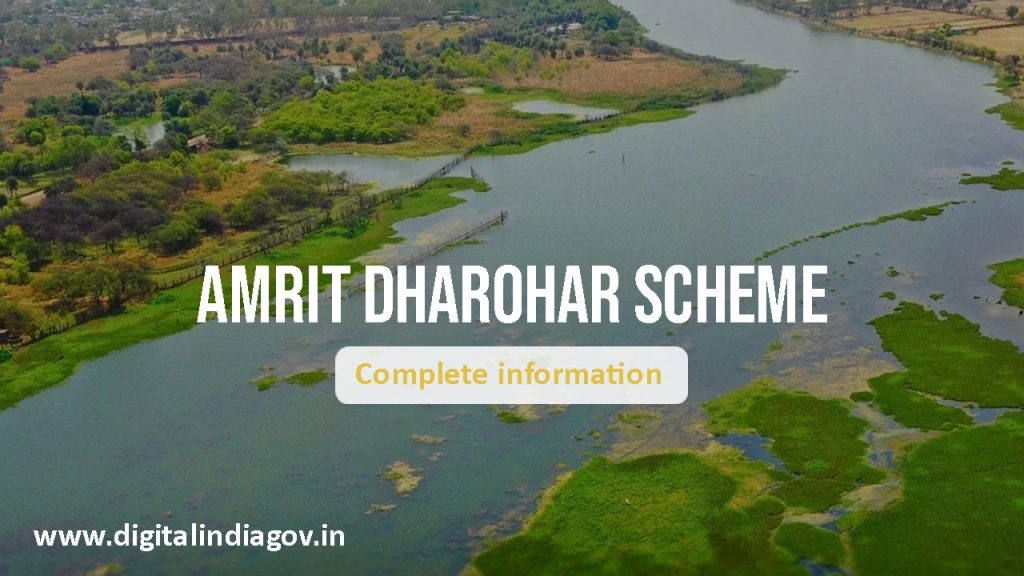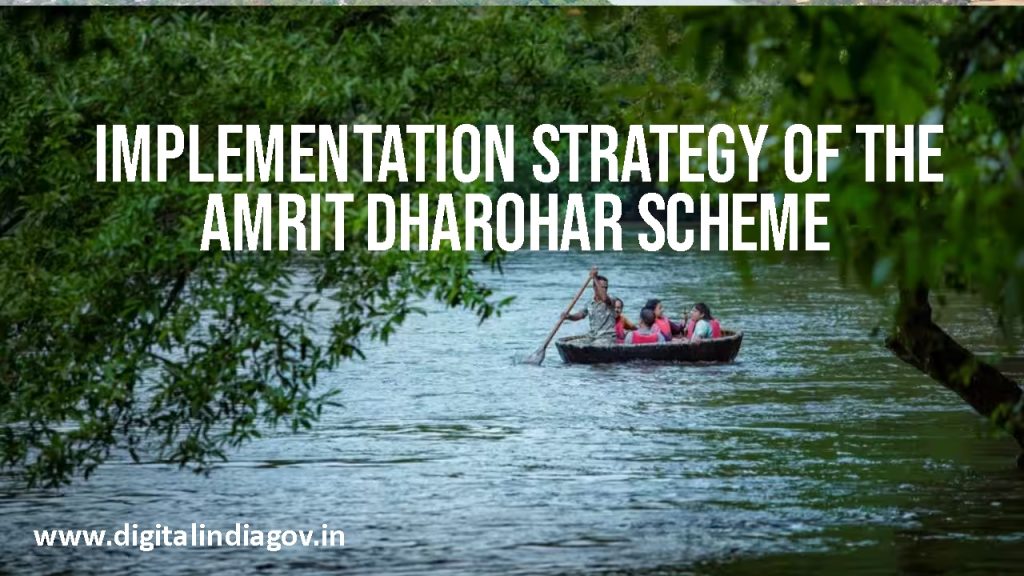Amrit Dharohar Scheme, भारत सरकार द्वारा देश भर में आर्द्रभूमि के संरक्षण और संधारणीय प्रबंधन में सुधार के लिए शुरू किया गया एक महत्वपूर्ण कार्यक्रम अमृत धरोहर योजना है। यह कार्यक्रम, जिसे केंद्रीय बजट 2023-24 के हिस्से के रूप में पेश किया गया था, इकोटूरिज्म, जैव विविधता संरक्षण और स्थानीय आजीविका के निर्माण का समर्थन करने के लिए है। हम इस पोस्ट में अमृत धरोहर योजना की विस्तार से जांच करेंगे, जिसमें इसके लक्ष्य, कार्यान्वयन के तरीके, लाभ और समग्र प्रभाव शामिल हैं।
Contents
What is the Amrit Dharohar Scheme?( अमृत धरोहर योजना क्या है?)
A government program called the Amrit Dharohar Scheme aims to protect India’s abundant wetland ecology while providing long-term financial advantages to nearby people. The program’s main objectives are to increase biodiversity protection, encourage carbon sequestration, and improve the ecological health of wetlands.
Key Highlights of the Amrit Dharohar Scheme:
- Announced in the Union Budget 2023-24.
- Focuses on wetland conservation and sustainable eco-tourism.
- Encourages community participation in wetland preservation.
- Supports India’s commitment to climate action and biodiversity protection.
- Enhances the potential of Ramsar Sites for sustainable development.
Also Read: Saksham Yuva Scheme, Digitizeindiagovin.com, Nebsit Council
Objectives of the Amrit Dharohar Scheme(अमृत धरोहर योजना के उद्देश्य)

अमृत धरोहर योजना के मुख्य लक्ष्य निम्नलिखित हैं:
- आर्द्रभूमि पर्यावरण का संरक्षण और सुधार करना, जो विभिन्न प्रकार के पौधों और जानवरों की प्रजातियों के लिए घर प्रदान करता है, जैव विविधता संरक्षण के रूप में जाना जाता है।
- पर्यावरण के अनुकूल यात्रा रणनीतियों को बढ़ावा देना जो क्षेत्रीय अर्थव्यवस्था को ऊपर उठाते हैं और पर्यावरण की रक्षा करते हैं, उन्हें इको-टूरिज्म के रूप में जाना जाता है।
- सामुदायिक भागीदारी: रोजगार सृजन और आर्द्रभूमि संरक्षण पहलों में स्थानीय लोगों को शामिल करना।
- जलवायु परिवर्तन के शमन में सहायता के लिए कार्बन सिंक के रूप में आर्द्रभूमि को बढ़ावा देना कार्बन पृथक्करण के रूप में जाना जाता है।
- सतत विकास पर्यावरण संरक्षण और आर्थिक विकास के बीच संतुलन बनाने का दीर्घकालिक लक्ष्य है।
Why is the Amrit Dharohar Scheme Important?( अमृत धरोहर योजना क्यों महत्वपूर्ण है?)
Wetlands are essential to preserving natural harmony. They serve as habitats for a variety of animals, natural filters, and water storage facilities. These habitats are in danger, though, due to rising urbanization, pollution, and climate change.
The objectives of the Amrit Dharohar Scheme are:
- Repair damaged wetlands and stop additional harm.
- Increase water retention capacity to lower the likelihood of droughts and floods.
- Encourage ecotourism to give the locals more sources of income.
- Reduce pollution in wetland areas to improve the quality of the water.
- Enhance wetland-based carbon storage to help India achieve its climate goals.
Future Prospects of the Amrit Dharohar Scheme(अमृत धरोहर योजना की भविष्य की संभावनाएं)
अमृत धरोहर योजना में आर्द्रभूमि के संरक्षण के लिए भारत के प्रयासों में क्रांतिकारी बदलाव लाने की क्षमता है। दीर्घकालिक सफलता के लिए निम्नलिखित कार्यों पर विचार किया जा सकता है:
- योजना को रामसर साइटों से आगे बढ़ाकर अधिक आर्द्रभूमि तक ले जाना।
- समुदाय द्वारा चलाए जा रहे संरक्षण पहलों का समर्थन करना।
- प्रौद्योगिकी और वैज्ञानिक अनुसंधान के एकीकरण में सुधार करना।
- दीर्घकालिक वित्तीय सफलता की गारंटी के लिए स्थायी पर्यटन के लिए मॉडल तैयार करना।
- आर्द्रभूमि के संरक्षण के लिए सार्वजनिक शिक्षा पहलों का विस्तार करना।
Also Read: Samarth Scheme UPSC, Mobilenumbertrackeronline, ssorajasthanidlogin.com, shaladarpanportalgov.com
Implementation Strategy of the Amrit Dharohar Scheme(अमृत धरोहर योजना की कार्यान्वयन रणनीति)

To ensure effective implementation, the scheme follows a well-defined approach:
- Identification of Wetlands:
- Priority is given to Ramsar Sites (wetlands of international importance).
- Other ecologically significant wetlands are also considered.
- Community Participation:
- Local communities are encouraged to take active roles in wetland protection and management.
- Training programs are conducted for eco-tourism and conservation techniques.
- Government and Private Sector Involvement:
- Partnerships with NGOs, researchers, and businesses to enhance conservation efforts.
- Private investments in eco-tourism and sustainable business models.
- Technology and Innovation:
- Use of satellite imaging and AI-based monitoring systems.
- Scientific research for improving wetland health and biodiversity.
- Funding and Financial Support:
- The government allocates specific funds for conservation projects.
- Corporate Social Responsibility (CSR) initiatives are encouraged.
Benefits of the Amrit Dharohar Scheme(अमृत धरोहर योजना के लाभ)
इस योजना से अर्थव्यवस्था, समुदाय और पर्यावरण को कई लाभ होंगे:
1. Environmental Benefits(पर्यावरणीय लाभ)
- क्षरण को कम करता है और आर्द्रभूमि संरक्षण में सुधार करता है।
- लुप्तप्राय जीवों को रहने के लिए जगह देकर जैव विविधता के संरक्षण का समर्थन करता है।
- पानी की गुणवत्ता बढ़ाने के लिए एक प्राकृतिक निस्पंदन प्रणाली के रूप में कार्य करता है।
- कार्बन पृथक्करण को बढ़ावा देकर जलवायु परिवर्तन को कम करने में सहायता करता है।
2. Economic Benefits(आर्थिक लाभ)
- इको-टूरिज्म को बढ़ावा देता है, स्थानीय समुदायों के लिए रोजगार और आय का सृजन करता है।
- टिकाऊ कृषि और मछली पकड़ने की प्रथाओं को प्रोत्साहित करता है।
- हरित व्यवसायों और प्रकृति-आधारित पर्यटन मॉडल को बढ़ावा देता है।
3. Social Benefits(सामाजिक लाभ)
- पर्यटन और संरक्षण उद्योगों में रोजगार प्रदान करता है।
- पर्यावरण संरक्षण और सामुदायिक जागरूकता में भागीदारी बढ़ाता है।
- आर्द्रभूमि आवासों से जुड़ी सांस्कृतिक संपत्तियों के संरक्षण को प्रोत्साहित करता है।
Challenges in Implementing the Amrit Dharohar Scheme(अमृत धरोहर योजना के क्रियान्वयन में चुनौतियाँ)
Despite its promising objectives, the scheme faces several challenges:
- Lack of Awareness: Many local communities are unaware of the importance of wetlands and their conservation.
- Pollution and Encroachment: Illegal land use, industrial waste, and urban expansion threaten wetlands.
- Climate Change Impact: Rising temperatures and erratic rainfall patterns affect wetland ecosystems.
- Funding Constraints: Continuous financial support is required for long-term conservation efforts.
- Coordination Issues: Effective collaboration between central, state, and local authorities is needed for better execution.
Comparison: Amrit Dharohar Scheme vs. Wetlands (Conservation and Management) Rules, 2017
| Feature | Amrit Dharohar Scheme | Wetlands (Conservation and Management) Rules, 2017 |
| Focus | Conservation & eco-tourism | Regulatory framework for wetland protection |
| Implementation | Community-based approach | Government-led protection laws |
| Economic Aspect | Promotes livelihood through eco-tourism | Primarily focuses on wetland preservation |
| Sustainability | Encourages public-private partnerships | Government monitoring and regulation |

Also Read: Griha Aadhar Scheme, yojanaforall.com, Typingspeedtestonline, Onlinereferjobs
Conclusion
भारत की आर्द्रभूमि की रक्षा, पारिस्थितिकी पर्यटन को प्रोत्साहित करने और सतत विकास का समर्थन करने की दिशा में एक महत्वपूर्ण कदम अमृत धरोहर योजना है। इस योजना का उद्देश्य एक संतुलित पारिस्थितिकी तंत्र स्थापित करना है, जहाँ स्थानीय आबादी को शामिल करके और समकालीन संरक्षण विधियों को शामिल करके प्रकृति और अर्थव्यवस्था एक साथ रह सकें। कार्यान्वयन की सफलता सार्वजनिक, कॉर्पोरेट क्षेत्र और सरकार सहित सभी संबंधित पक्षों की सक्रिय भागीदारी पर निर्भर करेगी। अमृत धरोहर योजना में सतत विकास और आर्द्रभूमि संरक्षण के लिए एक विश्व मॉडल बनने की क्षमता है, अगर इसे अच्छी तरह से लागू किया जाए।
Faq’s
Q. The Amrit Dharohar Scheme was introduced when?
Ans: The Union Budget 2023–24 announced to support sustainable tourism and wetland restoration.
Q. What are the scheme’s primary goals?
Ans: Conservation of biodiversity, development of ecotourism, community involvement, and climate action are among its primary goals.
Q. In what ways does the plan help the community?
Ans: It generates jobs in eco-friendly enterprises, tourism, and conservation.
Q. What obstacles does the plan have to overcome?
Ans: Pollution, ignorance, the effects of climate change, and financial limitations are among the difficulties.
Q. What role may individuals play in this endeavor?
Ans: By supporting sustainable tourism, taking part in conservation initiatives, and increasing awareness, everyone can help.
@PAY
